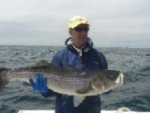Pfiesteria piscicida is a microscopic estuarine dinoflagellate protozoan. Scientists are actively studying the organism and there is still much that we do not know about it. We do know that Pfiesteria piscicida and possibly other related, but unnamed, organisms (referred to as "Pfiesteria-like") have caused large fish kills in a number of nutrient enriched tributaries of Chesapeake Bay in Maryland and coastal estuaries in North Carolina.
Laboratory research with this organism indicates that it can exist in as many as 24 different life stages. Like many other dinoflagellate (free swimming) microorganisms, Pfiesteria piscicida can survive for long periods in sediments in a cyst or spore form. Under certain conditions, Pfiesteria piscicida experiences a large population increase, or "bloom". During a bloom, in the presence of large concentrations of fish in calm, shallow waters, this organism can change into a free-swimming form that produces a toxin that causes deep, ulcerative lesions in fish and can kill large numbers of fish.
The free swimming form of Pfiesteria piscicida which produces the toxin only exists for a very short period of time during the fish kill. In its other more common forms, Pfiesteria piscicida may spend its entire life feeding harmlessly on bacteria and algae. While it is currently not well understood what environmental factors induce Pfiesteria piscicida to change into its toxic form, it has been shown in the laboratory that blooms of the free swimming toxic form are induced by nutrient enrichment and the presence of large amounts of fresh fish excreta.
The exact chemistry and biology of the toxin is unknown; however, it is known that Pfiesteria piscicida itself is not an infectious agent; it does not spread from fish to fish or from fish to humans. The toxin is very short-lived in water. In fact, samples must be taken during an active kill or lesion event in order for Pfiesteria piscicida to be identified.




















